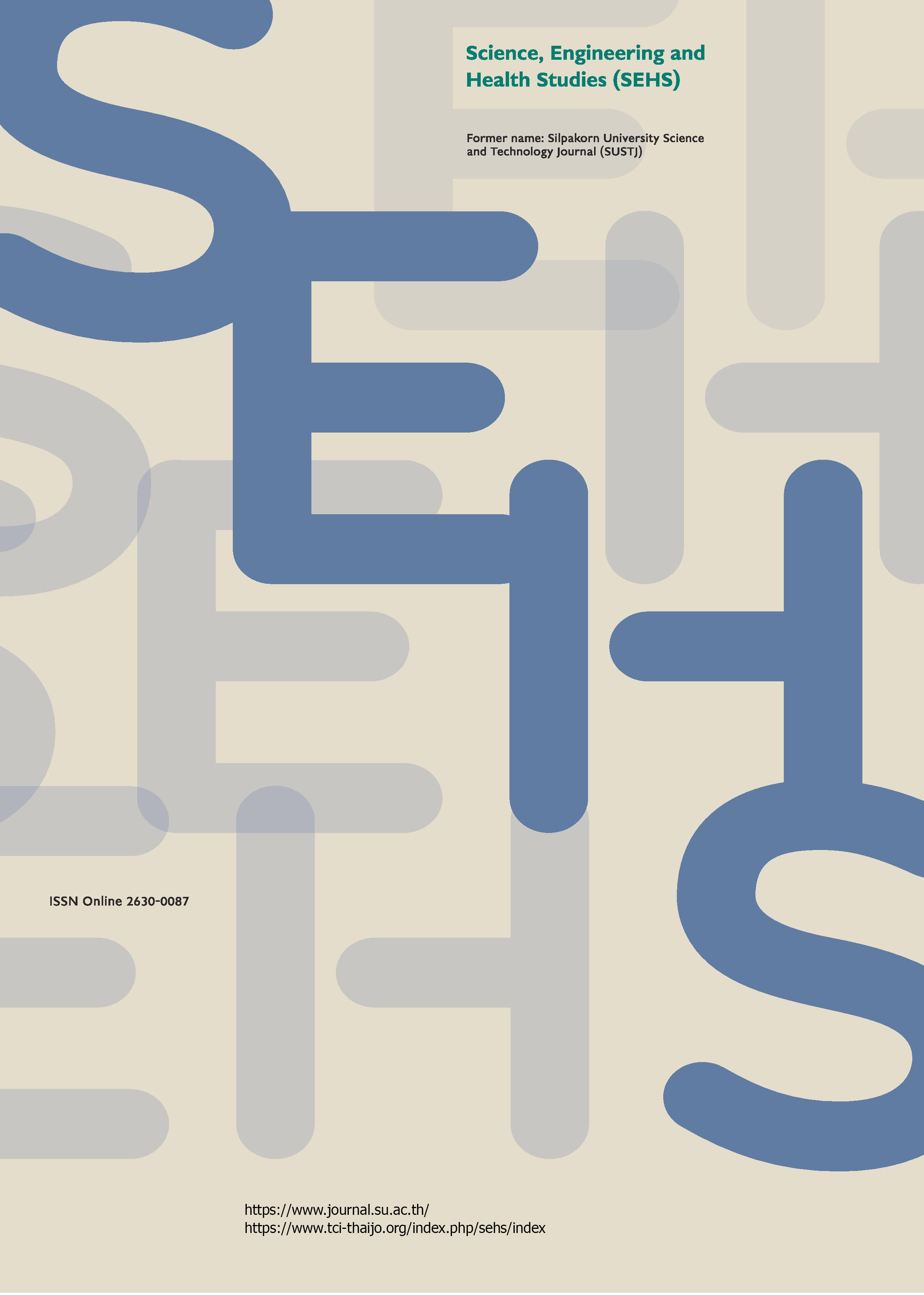Assessment of heavy metal concentration in wastewater of silk dyeing in Kalasin, Thailand
Main Article Content
Abstract
Mudmee silk is a well-known product of Ban Non-Chard village, Kalasin, Thailand. Untreated wastewater from dyeing process and washing dyed silk yarns is generally discharged into the environment. This study aimed to assess the heavy metals (Cd, Cr, and Pb) in effluents produced by dyeing silk yarns in three colors. The 39 effluent samples from different houses were collected and classified by color, i.e., black, red, and yellow. An atomic absorption spectrometer was used to determine the heavy metal concentrations. The results were evaluated in accordance with the wastewater standards of the World Health Organization (WHO). The mean concentration values of heavy metals in wastewater samples were found to occur in the order Cr > Pb > Cd. The results showed that the black dye effluents had significantly higher concentrations of Cr than other colors dye effluents. All samples of red, black, and yellow effluents had pH values within the permissible limits, excepting three samples of black effluents. The metals Cd, Cr, and Pb were found in most red, black, and yellow effluent samples, and most concentrations exceeded the WHO standard.
Downloads
Article Details

This work is licensed under a Creative Commons Attribution-NonCommercial-NoDerivatives 4.0 International License.
References
Abdel-Raouf, M. S., and Abdul-Raheim, A. R. M. (2017). Removal of heavy metals from industrial waste water by biomass-based materials: a review. Journal of Pollution Effects and Control, 5(1), 1-13.
Akter, M. S., Islam, M. N., Fardous, Z., Khan, M. H., and Rahman, M. A. (2010). Assessment of heavy metals in handloom cottage, dyeing and printing industrial effluents in Belkuchi, Sirajganj. Journal of Applied Science and Technology, 7(2), 85-90.
American Public Health Association. (2017). Standard method for the examination of water and wastewater, 23rd, Washington: APHA, pp. 325-354.
Bhardwaj, V., Kumar, P., and Singhal, G. (2014). Toxicity of heavy metals pollutants in textile mills effluents. International Journal of Scientific and Engineering Research, 5(7), 664-666.
Bishnoi, O. P., and Roy, S. (2017). Physico-chemical studies of effluent in Sanganer area. International Journal of Pharmaceutical and Biological Archives, 8(1), 34-37.
Chiamsathit, C., Auttamana, S., and Thammarakcharoen, S. (2020). Heavy metal pollution index for assessment of seasonal groundwater supply quality in hillside area, Kalasin, Thailand. Applied Water Science, 10(142), 1-8.
El-Rahim, W. M., Khali, W. K. B., and Eshak, M. G. (2008). Genotoxicity studies on the removal of a direct textile dye by a fungal strain, in vivo, using micronucleus and RAPD-PCR techniques on male rats. Journal of Applied Toxicology, 28(4), 484-490.
Husain, Q. (2006). Potential applications of the oxidoreductive enzymes in the decolorization and detoxification of textile and other synthetic dyes from polluted water: a review. Critical Reviews in Biotechnology, 26(4), 201-221.
Hussain, S., Khan, N., Gul, S., Khan, S., and Khan, H. (2019). Contamination of water resources by food dyes and its removal technologies. IntechOpen. [Online URL: https://www.intechopen.com/chapters/70455] accessed on July 15, 2020.
Jaishree, and Khan, T. I. (2014). Monitoring of heavy metal in textile waste water of Sanganer, Jaipur (Rajasthan). International Journal of Scientific and Research Publications, 4(3), 1-4.
Johari, K., Saman, N., Song, S. T., Chin, C. S., Kong, H., and Mat, H. (2016). Adsorption enhancement of elemental mercury by various surface modified coconut husk as eco- friendly low-cost adsorbents. International Biodeterioration and Biodegradation, 109, 45–52.
Kuntacha, A. (1999). Lead and Chromium contamination useless water from Krajut dyeing at Talenoi. Research report. Taksin University, Thailand.
Mishra, P., and Soni, R. (2016). Analysis of dyeing and printing waste water of Balotara textile industries. International Journal of Chemical Science, 14(4), 1929-1938.
Qin, H., Su, Q., Khu, S., and Tang, N. (2014). Water quality changes during rapid urbanization in the Shenzhen river catchment: an integrated view of socio-economic and infrastructure development. Sustainability, 6, 7433-7451.
Siyanbola, T. O., Ajanaku, K. O., James, O. O., Olugbuyiro, J. A. O., and Adekoya, J. O. (2011). Physico-chemical characteristics of industrial effluents in Lagos state, Nigeria. Global Journal of Pure and Applied Science and Technology, 1, 49-54.
Sorsa, S., Chibssa, Y., Tilahun, G., and Fitamo, D. (2015). Heavy metal concentrations and physicochemical characteristics of effluent along the discharge route from Hawassa textile factory, Ethiopia. Journal of Environmental and Analytical Toxicology, 5(4), 1-7.
Pollution Control Department. (2016). The standards for controlling the drainage of wastewater from a point source of industrial plants, industrial estate and industrial zones. [Online URL: https://www.pcd.go.th/wp-content/uploads/2020/05/pcdnew-2020-05-20_03-06-17_069400.pdf] accessed on January 15, 2020.
Thongthummachat, S., Srichooyong, C., Varin, W., and Pimchan, P. (2011). Determination of heavy metals in synthesized dye following with natural color producting for reed. Rajabhat Maha Sarakham University Journal, 5(2), 193-203. [Online URL: https://so05.tcithaijo.org/index.php/rmuj/issue/view/2602] accessed on 18 May, 2011.
Varghese, A. G., Paul, S. A., and Latha, M. S. (2018). Cellulose based green adsorbents for pollutant removal from wastewater. In Green Adsorbents for Pollutant Removal (Crini, G., and Lichtfouse, E., eds.), pp. 127-157. New York: Springer International Publishing.
World Health Organization. (2003). Environment protection act. standards for effluent discharge regulations. Geneva: General Notice No 44. [Online URL: https://www.informea.org/en/legislation/environment-protection-standards-effluent-discharge-regulations-2003-gn-no-44-2003] accessed on January 15, 2020.


